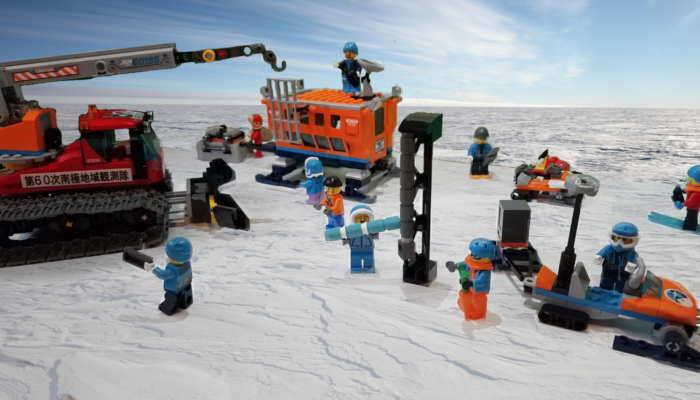Women make up 50.8% of the world’s population, yet fewer than 30% of the world’s researchers are women. Of this percentage, women of colour comprise around 5%, with less than 1% represented in geoscience faculty positions. Women are published less, paid less, and do not progress as far in their careers as men. Even within our EGU community, women account for only one third of all members, an ...[Read More]
If you didn't find what you was looking for try searching again.
Cryospheric Sciences
Did you know… the surface of melting glaciers is one of the most radioactive places on Earth?
Recent studies show that glaciers are significantly affected by pollution, and in general by human activities, but few people would imagine that their surface contains traces of nuclear contamination and radioactivity. It has been recently claimed that high amounts of radioactivity have accumulated on glaciers, only beaten by the radioactivity levels of sites where nuclear incidents and tests have ...[Read More]
Cryospheric Sciences
Did you know… tropical cyclones cause large snowfall on Kilimanjaro’s glaciers?
Tropical cyclones are an important part of the weather in the southwest Indian Ocean each year, from November through April. These storms can cause massive destruction and loss of life when they make landfall, which happens most often on the islands of Mauritius and Madagascar and the coastal region of Mozambique. However, until recently, relatively little was known about their impacts on the high ...[Read More]
Cryospheric Sciences
©LEt’sGO to Antarctica !
With the current situation, polar fieldwork might be/have been cancelled and we have a suggestion to remedy your field-blues… Why not use ©LEGO to pretend you’re back in the field with the added bonus that you get to be in the warmth and comfort of your home! Here, we’ve re-enacted radar fieldwork that took place a year and a half ago in Antarctica… But first, let’s start with some backgroun ...[Read More]
Cryospheric Sciences
Does debris cover offset glacier retreat in the Greater Caucasus?
In this week’s blog, Levan Tielidze tells us about supra-glacial debris cover change for the Greater Caucasus. His recent study indicates more than a doubling in the area of supra-glacial debris cover for the Elbrus Massif‘s glaciers from 1986 to 2014, the largest glacierized massif in the whole region. Glaciers on the western slope of the Elbrus Massif are affected by avalanches and thus ar ...[Read More]
Cryospheric Sciences
Life of a scientist: When fieldwork doesn’t go to plan…
Climate research questions tend to focus on the future. What will global temperature be in 2100? Will extreme weather events become more frequent? When will sea level rise render coastal homes uninhabitable? But our understanding of climate processes first comes from observing the past: palaeoclimatology. To get these records, scientists often go on fieldwork to collect samples. But what happens w ...[Read More]
Cryospheric Sciences
The foot of a glaciated mammoth? No… A glacier!
Ice is a viscous fluid: it flows but slowly, reaching up to 100 m/yr for the fastest flowing ice. That’s 0.00001 km/hr, so you’d never see it with the naked eye. But what influences the morphology of the glaciers is the shape of the topography that lies underneath them. Elephant Foot Glacier, shown above, aptly named for its shape, is a textbook-example of a piedmont glacier. These types of glacie ...[Read More]
Cryospheric Sciences
An interview with Jean Holloway on the importance of mental health in graduate school
Recent studies have shown that mental health conditions are far more common in graduate students than in the general public (e.g. Bolotnyy et al., 2020). Despite the prevalence, these issues are not something that are often openly discussed, and graduate students often don’t seek treatment. This week, we are interviewing Jean Holloway who aims to shed some light on her personal experience with som ...[Read More]
Cryospheric Sciences
Climate Change & Cryosphere – The fate of Georgian Glaciers
Display "The fate of Georgian Glaciers" from YouTube Click here to display content from YouTube. Learn more in YouTube’s privacy policy. Always display content from YouTube Open "The fate of Georgian Glaciers" directly Last week, we learned about the dramatic fate of the Hochjochferner, which has strongly retreated in the past years due to climate change. It represented just on ...[Read More]
Cryospheric Sciences
Education in glaciology: Witnessing the death of a glacier
The Karthaus summer school on Glaciers and Ice Sheets in the Climate System has a long history of training many generations of PhD students, thus forming professional networks that have lasted throughout their careers. The Karthaus summer school has been described in detail in a previous Cryoblog post. Here we want to focus on the story of a glacier… Hochjochferner, a retreating glacier One ...[Read More]









